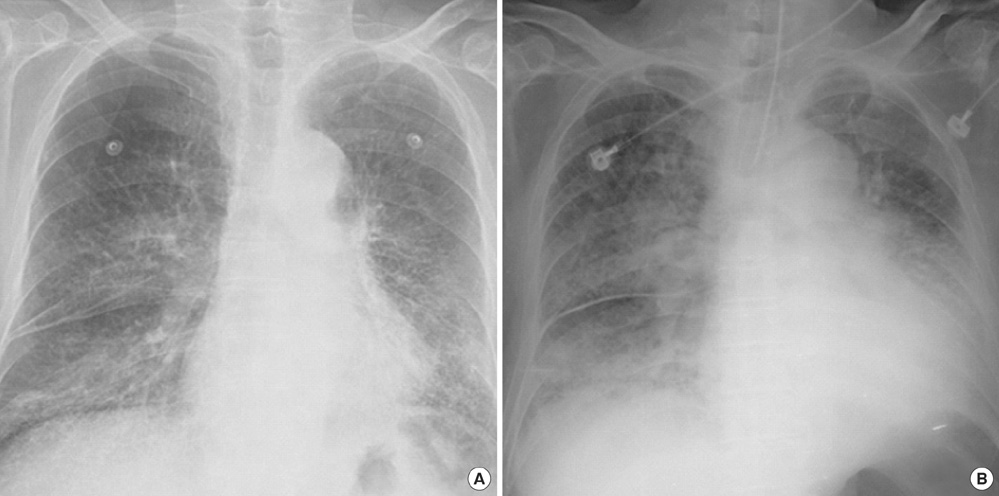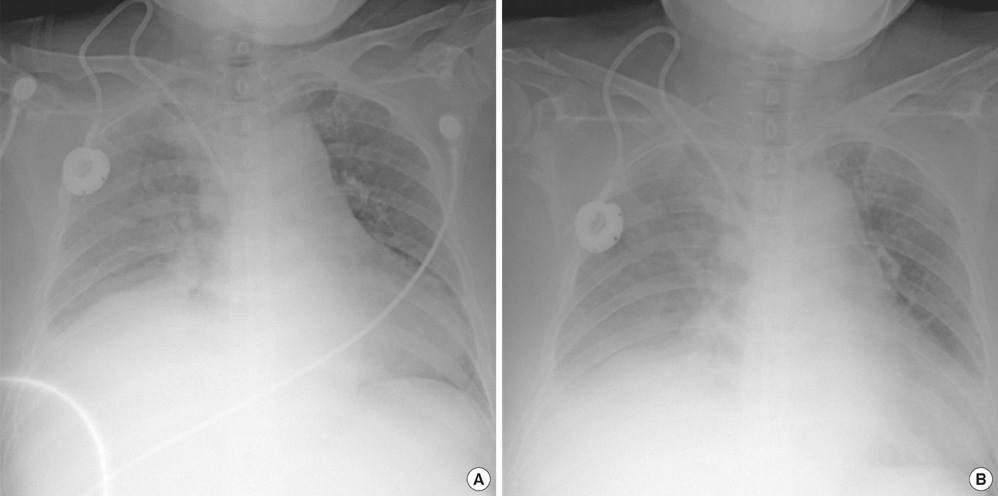J Korean Med Sci.
2010 Sep;25(9):1398-1403. 10.3346/jkms.2010.25.9.1398.
Two Cases of Transfusion-related Acute Lung Injury Triggered by HLA and Anti-HLA Antibody Reaction
- Affiliations
-
- 1Department of Laboratory Medicine and Genetics, Samsung Medical Center, Sungkyunkwan University School of Medicine, Seoul, Korea. eskang@skku.edu
- KMID: 1785927
- DOI: http://doi.org/10.3346/jkms.2010.25.9.1398
Abstract
- Transfusion-related acute lung injury (TRALI) is a serious adverse transfusion reaction that is presented as acute hypoxemia and non-cardiogenic pulmonary edema, which develops during or within 6 hr of transfusion. Major pathogenesis of TRALI is known to be related with anti-HLA class I, anti-HLA class II, or anti-HNA in donor's plasma. However, anti-HLA or anti-HNA in recipient against transfused donor's leukocyte antigens also cause TRALI in minor pathogenesis and which comprises about 10% of TRALI. Published reports of TRALI are relatively rare in Korea. In our cases, both patients presented with dyspnea and hypoxemia during transfusion of packed red blood cells and showed findings of bilateral pulmonary infiltrations at chest radiography. Findings of patients' anti-HLA antibodies and recipients' HLA concordance indicate that minor pathogenesis may be not as infrequent as we'd expected before. In addition, second case showed that anti-HLA class II antibodies could be responsible for immunopathogenic mechanisms, alone.
Keyword
MeSH Terms
-
Acute Lung Injury/*diagnosis/*immunology/radiography
Aged
Anoxia/diagnosis
Antigen-Antibody Reactions
Blood Transfusion/*adverse effects
Dyspnea/diagnosis
Female
HLA Antigens/*immunology
Histocompatibility Antigens Class I/immunology
Histocompatibility Antigens Class II/immunology
Humans
Isoantibodies/*blood
Male
Middle Aged
Figure
Cited by 2 articles
-
Convalescent Plasma Therapy in Coronavirus Disease 2019: a Case Report and Suggestions to Overcome Obstacles
Jae Hyoung Im, Chung Hyun Nahm, Ji Hyeon Baek, Hea Yoon Kwon, Jin-Soo Lee
J Korean Med Sci. 2020;35(26):e239. doi: 10.3346/jkms.2020.35.e239.A case of transfusion-related acute lung injury induced by anti-human leukocyte antigen antibodies in acute leukemia
Sun Mi Jin, Moon Ju Jang, Ji Young Huh, Myoung Hee Park, Eun Young Song, Doyeun Oh
Korean J Hematol. 2012;47(4):302-306. doi: 10.5045/kjh.2012.47.4.302.
Reference
-
1. Danielson C, Benjamin RJ, Mangano MM, Mills CJ, Waxman DA. Pulmonary pathology of rapidly fatal transfusion-related acute lung injury reveals minimal evidence of diffuse alveolar damage or alveolar granulocyte infiltration. Transfusion. 2008. 48:2401–2408.
Article2. Kleinman S, Caulfield T, Chan P, Davenport R, McFarland J, McPhedran S, Meade M, Morrison D, Pinsent T, Robillard P, Slinger P. Toward an understanding of transfusion-related acute lung injury: statement of a consensus panel. Transfusion. 2004. 44:1774–1789.
Article3. Middelburg RA, van Stein D, Briet E, van der Bom JG. The role of donor antibodies in the pathogenesis of transfusion-related acute lung injury: a systematic review. Transfusion. 2008. 48:2167–2176.
Article4. Huh JY, Han TH, Seo JW, Kim DC, Roh DH, Han KS. A case of transfusion-related acute lung injury. Korean J Blood Transfus. 2005. 16:250–254.5. Li G, Daniels CE, Kojicic M, Krpata T, Wilson GA, Winters JL, Moore SB, Gajic O. The accuracy of natriuretic peptides (brain natriuretic peptide and N-terminal pro-brain natriuretic) in the differentiation between transfusion-related acute lung injury and transfusion-related circulatory overload in the critically ill. Transfusion. 2009. 49:13–20.
Article6. Popovsky MA, Abel MD, Moore SB. Transfusion-related acute lung injury associated with passive transfer of antileukocyte antibodies. Am Rev Respir Dis. 1983. 128:185–189.7. Cherry T, Steciuk M, Reddy VV, Marques MB. Transfusion-related acute lung injury: past, present, and future. Am J Clin Pathol. 2008. 129:287–297.8. Fiebig EW, Wu AH, Krombach J, Tang J, Nguyen KA, Toy P. Transfusion-related acute lung injury and transfusion-associated circulatory overload: mutually exclusive or coexisting entities? Transfusion. 2007. 47:171–172.
Article9. Win N, Massey E, Lucas G, Sage D, Brown C, Green A, Contreras M, Navarrete C. Ninety-six suspected transfusion related acute lung injury cases: investigation findings and clinical outcome. Hematology. 2007. 12:461–469.
Article10. Win N, Chapman CE, Bowles KM, Green A, Bradley S, Edmondson D, Wallis JP. How much residual plasma may cause TRALI? Transfus Med. 2008. 18:276–280.
Article11. Su L, Kamel H. How do we investigate and manage donors associated with a suspected case of transfusion-related acute lung injury. Transfusion. 2007. 47:1118–1124.
Article12. Curtis BR, McFarland JG. Mechanisms of transfusion-related acute lung injury (TRALI): anti-leukocyte antibodies. Crit Care Med. 2006. 34:5 Suppl. S118–S123.
Article13. Steciuk M, Marques MB. A new "initial" case of transfusion-related acute lung injury. Blood. 2008. 111:5257–5258.
Article14. Stroncek DF, Klein HG. Heavy breathing in the blood bank: is it transfusion-related acute lung injury, our anxiety, or both. Transfusion. 2007. 47:559–562.
Article15. Bux J, Becker F, Seeger W, Kilpatrick D, Chapman J, Waters A. Transfusion-related acute lung injury due to HLA-A2-specific antibodies in recipient and NB1-specific antibodies in donor blood. Br J Haematol. 1996. 93:707–713.
Article16. Nishimura M, Hashimoto S, Takanashi M, Okazaki H, Satake M, Nakajima K. Role of anti-human leucocyte antigen class II alloantibody and monocytes in development of transfusion-related acute lung injury. Transfus Med. 2007. 17:129–134.
Article17. Flesch BK, Neppert J. Transfusion-related acute lung injury caused by human leucocyte antigen class II antibody. Br J Haematol. 2002. 116:673–676.
Article18. Kopko PM, Paglieroni TG, Popovsky MA, Muto KN, MacKenzie MR, Holland PV. TRALI: correlation of antigen-antibody and monocyte activation in donor-recipient pairs. Transfusion. 2003. 43:177–184.
Article19. Sachs UJ. The pathogenesis of transfusion-related acute lung injury and how to avoid this serious adverse reaction of transfusion. Transfus Apher Sci. 2007. 37:273–282.
Article20. Cohen H, Taylor C, Mold D, Jones H. The 2008 Annual SHOT(Serious Hazards of Transfusion) Report. 2009. accessed on Nov. 15 2009. Available at http:www.shot-uk.org.
- Full Text Links
- Actions
-
Cited
- CITED
-
- Close
- Share
- Similar articles
-
- A Case Report of Transfusion-Related Acute Lung Injury Induced in the Patient with HLA Antibody after Fresh Frozen Plasma Transfusion
- A case of transfusion-related acute lung injury induced by anti-human leukocyte antigen antibodies in acute leukemia
- Study on the Promotion of HLA-matched Platelet Supply in Korea
- Transfusion-related Acute Lung Injury
- Positive Rate of HLA Class I Antibodies in Multiparous Korean Women



